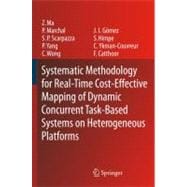
What is included with this book?
| Introduction | |
| The System-on-Chip Era | |
| Characteristics of Embedded Software | |
| Context and Motivation | |
| TCM Framework | |
| Overview of Chapters | |
| Related Work | |
| Real-time Scheduling | |
| Low-power Considerations | |
| Platform Issues and Co-design Framework | |
| System Model and Work flow | |
| Overview of TCM Work flow | |
| Gray-box Model | |
| System Scenario Selection | |
| Two-phase Scheduling | |
| Summary | |
| Basic Design-time Scheduling | |
| Problem Formulation | |
| Exact Scheduling Algorithms | |
| Forward Search Algorithm | |
| Backward Search Algorithm | |
| Sub-platform Scheduling | |
| Handling Timing-Constraints | |
| Summary | |
| Scalable Design-time Scheduling | |
| Introduction | |
| Motivational Example | |
| Thread Frame Decomposition | |
| Thread Partition Clustering | |
| Thread Partition Interleaving | |
| Experimental Results and Discussions | |
| Comparison with State of the Art | |
| Summary | |
| Fast and Scalable Run-time Scheduling | |
| Two-Phase Task Scheduling: Why and How | |
| Run-time Scheduling Algorithm | |
| Experimental Results | |
| Summary | |
| Handling of Multi-dimensional Pareto Curves | |
| Overview of The Customized Run-time Management | |
| Problem Formulation of Run-time Operating Point Selector | |
| Related Work | |
| MP-SoC Heuristic Description | |
| Experimental Results | |
| Summary | |
| Run-time Software Multithreading | |
| Motivation of Run-time Re-scheduling | |
| Run-time Interleaving | |
| Experimental Results and Discussion | |
| Comparison with State of the Art | |
| Summary | |
| Fast Source-level Performance Estimation | |
| Introduction | |
| Motivational Example | |
| Comparison With State of The Art | |
| Fundamentals of The Estimation Technique | |
| Experimental Results | |
| Summary | |
| Handling of Task-level Data Communication and Storage | |
| Memory Architecture | |
| Exploring Thread Node Level Data Reuse | |
| Data Assignment On L1 Memory Layer | |
| Bandwidth Aware Scheduling | |
| Handling inter-TN and inter-TF Data Transfers | |
| Summary | |
| Demonstration on Heterogeneous Multiprocessor SoCs | |
| Motivation for Heterogeneous Multiprocessor Platforms | |
| Mapping Visual Texture Coding Decoder | |
| Summary | |
| Conclusions and future research work Input and output data of scheduling examples in | |
| References | |
| Table of Contents provided by Publisher. All Rights Reserved. |
The New copy of this book will include any supplemental materials advertised. Please check the title of the book to determine if it should include any access cards, study guides, lab manuals, CDs, etc.
The Used, Rental and eBook copies of this book are not guaranteed to include any supplemental materials. Typically, only the book itself is included. This is true even if the title states it includes any access cards, study guides, lab manuals, CDs, etc.